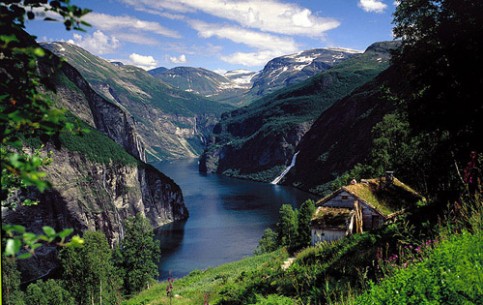
Being one of Europe’s last natural frontiers it evokes a sense of timelessness. In this enduring landscape, nature is at her most dramatic spectacle of the fjords is a natural wonder.
Norway is well known for its amazing and varied nature. The nearly deserted roads that wind through vast forested lands of Norway are a joy. A fjord is a valley formed by glaciers and filled with the sea to form a steep-walled inlet. There are two of the world’s three longest fjords in Norway. The fjords in the west of the country are long narrow inlets, flanked on either side by tall mountains where the sea penetrates far inland. Travelers inevitably discover many treasures of nature and culture in Fjord Norway. UNESCO has included four of these on its World Heritage List. The Nærøyfjord is the narrowest fjord in the world, at one point only 250 metres wide, with mountains towering more than a thousand meters above its tranquil waters. The Geirangerfjord, farther north, is known for its pristine beauty and magnificent waterfalls. Peering down onto the fjords from fertile mountain ledges there are farms, some of them still in use. For 850 years, Urnes stave church has kept watch over the beautiful Lusterfjord. Intertwined animal figures are carved deep into the west and north portal to the best preserved of Norway’s 28 remaining stave churches.
Waterfalls are among Norway's finest attractions, and they abound in Fjord Norway. The waterfalls are not just beautiful to look at; they are also important sources of energy. Hydroelectric power is almost the only source of electricity in Norway.
The climate in the western Fjord areas is excellent for fruit growing, with the most spectacular late spring fruit blossom you have ever seen. The strawberries, cherries and raspberries are extremely tasty due to the growing conditions of the short, bright summers. The long coast provides the region with fresh fish and seafood, and the smoked salmon is local specialty.
Related objects
 |
|
 |
|
 |
|
 |
|
 |
|
 |
|
 |
|
 |
|
 |
|
 |
|
 |
|
 |
|
 |
|
 |
|
 |
|
 |
|
 |
|
 |
|
 |
|
 |
|
 |
|
 |
|
 |
|
 |
|
 |
|
 |
|
 |
|
 |
|
 |
|
Norway • News
![]() Norway • 2015-07-02
Norway • 2015-07-02
Norwegian Cruise Line launches 7-Day Sale from July 1 to 7, 2015 ...
![]() Norway • 2015-06-30
Norway • 2015-06-30
Norwegian Cruise Line appoints cruise brand specialist as new Managing Director Europe ...
![]() Norway • 2014-12-11
Norway • 2014-12-11
NORWEGIAN CRUISE LINE UNVEILS 2016/2017 ITINERARIES ...
![]() Norway • 2014-12-08
Norway • 2014-12-08
Norwegian Cruise Line sets sail for exclusive partnership with Margaritaville® ...
![]() Norway • 2014-12-08
Norway • 2014-12-08
A Christmas gift from Norwegian Cruise Line – up to $1.000 on-board credit per stateroom ...





